Servicios Personalizados
Articulo
Indicadores
Links relacionados
-
 Citado por Google
Citado por Google -
 Similares en Google
Similares en Google
Compartir
South African Journal of Science
versión On-line ISSN 1996-7489
versión impresa ISSN 0038-2353
S. Afr. j. sci. vol.104 no.11-12 Pretoria nov./dic. 2008
SCIENCE POLICY
A comparison of the cost of research in South Africa's public research and higher education institutions
D.R. Walwyn
Graduate School of Technology Management, University of Pretoria, Pretoria 0002, South Africa. E-mail: dwalwyn@arvir.co.za
ABSTRACT
Despite the importance of labour and overhead costs to both funders and performers of research in South Africa, there is little published information on the remuneration structures for researchers, technician and research support staff. Moreover, there are widely different pricing practices and perceptions within the public research and higher education institutions, which in some cases do not reflect the underlying costs to the institution or the inherent value of the research. In this article, data from the 2004/5 Research and Development Survey have been used to generate comparative information on the cost of research in various performance sectors. It is shown that this cost is lowest in the higher education institutions, and highest in the business sector, although the differences in direct labour and overheads are not as large as may have been expected. The calculated cost of research is then compared with the gazetted rates for engineers, scientists and auditors performing work on behalf of the public sector, which in all cases are higher than the research sector. This analysis emphasizes the need within the public research and higher education institutions for the development of a common pricing policy and for an annual salary survey, in order to dispel some of the myths around the relative costs of research, the relative levels of overhead ratios and the apparent disparity in remuneration levels.
Introduction
Very few subjects arouse quite as much general interest within the research community as the salaries of academics and science council employees. Are academics underpaid or overpaid? Is the South African cost of research, which is driven mainly by labour costs, too high and in particular too high relative to the emerging economies of India and China? Are salaries in the science councils out of line with those of their peers in the universities? Do overheads in South African universities and science councils differ widely, both between institutions and in comparison with similar international organizations?
It is not only the researchers who are interested in this subject; it is also research managers and funding agencies. As South Africa increases its expenditure on research and development (R&D),1 the unit cost of research becomes a critical factor. In all likelihood, more funds pursuing the same pool of researchers and equipment will drive up costs while keeping output levels mostly constant. This would not be a desirable outcome; the expectation of the funders of research is that additional expenditure will translate into higher science and technology (S&T) outputs and increased innovation.
But the possibility of severe inflation within the research and development community is not the only problem facing research managers. The universities are all battling with the issue of full-cost accounting and establishing a fair cost for research within their institutions. As contract R&D incomes rise, so too does the university debt burden, suggesting that the universities are directly subsidizing such activities within their institutions.
It is therefore surprising that little attention has been paid to the unit cost of research within the national system of innovation. Despite its importance, there is almost no published information on remuneration levels within the research community. For instance, there is no salary survey dedicated to the science councils and the universities, and there are widespread disparities as to how a unit cost of research is actually calculated. Although the recommended rates for scientists and engineers who perform consultancy work and are registered in terms of the Natural Scientific Professions Act (Act 27 of 2003) and the Engineering Profession Act (Act 46 of 2000), respectively, are published annually in the Government Gazette,2,3 no such rates are published for researchers working in public research institutions (PRIs), including the science councils and the universities. As a result, very little public information is available on the cost of research in PRIs or how such costs are calculated. In this article, data from the 2004/5 R&D survey4 are used to derive and hence compare the cost of research between the performance sectors of the higher education institutions (HEIs), the science councils and the business sector.
This initial analysis shows that research costs and, by implication, salaries are highest in the business sector, and lowest in the HEIs. However, the differences are not as wide as may be expected and this analysis supports the need for more regular and detailed surveys in order to obtain a more accurate understanding of the researcher labour market. This information will also be helpful in developing a common pricing policy for universities and science councils.
Cost of research from the R&D survey
Salary and other cost information for most PRIs is not readily available. Although there are salary surveys, the respondents are taken mainly from the private and state-owned enterprises sector, and do not include academic researchers. The complete lack of salary information for the higher education institutions is indeed a major problem, as it contributes to the distortions and perceptions of the research labour market.
As a result, data on the relative costs of research between the various performance sectors have been obtained indirectly from the 2004/5 R&D survey.4 This survey contains information on the total numbers and full-time equivalents (FTEs) of R&D employees (divided into the sub-categories of researchers, technicians, and support staff), labour costs (divided as for employee numbers), capital expenses and other costs (where 'other' is the difference between total R&D expenditure and labour plus depreciation costs). Data on FTE rates are crucial for a comparison of this nature, because in many instances R&D employees are involved in functions in addition to research (such as teaching or knowledge-based services).
The survey data have been processed to derive the unit FTE rates for each sector (government, science councils, business, higher education sector, and not for profit organizations) and for the three categories of researchers, technicians and 'other' within each sector, where the unit FTE rate is defined as the labour cost per FTE. This information is presented in Fig. 1, which indicates that science council FTE rates are higher than the HEIs' but lower than the business sector's, where the latter is a collective term for the private sector and state-owned enterprises.
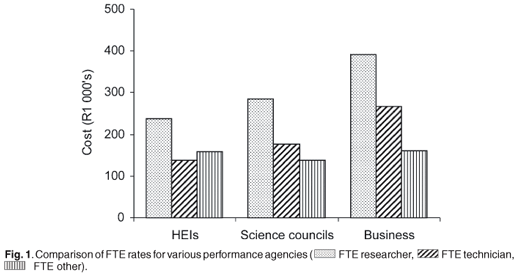
The R&D survey data have also been used to compare the overhead costs, which are defined as all costs excluding the labour of researchers and technicians (collectively referred to as the S&T base) and the estimated running expenses (the latter usually varies from between 5% and 20%, but a flat rate of 10% of the total project cost has been used for this analysis). This particular approach to the allocation of overhead costs is common in research organizations and consultancies due to its utility in ensuring cost recovery. It is noted that overheads as a percentage of total expenditure are typically 50–55% of the total project costs, respectively, and this figure is reasonably consistent between the different performance sectors (see Fig. 2).
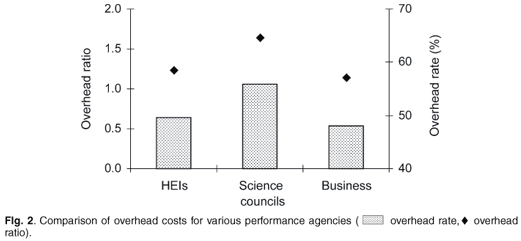
The ratio of overhead costs to total project cost is referred to as the overhead rate and is usually expressed as a percentage of the total project cost. The overhead cost can also be expressed as the overhead ratio, however, which is defined as the ratio between total overhead costs and the labour cost of researchers and technicians. The overhead ratio varies between 1.2 and 1.8, with the highest value in the science councils and the lowest in the business sector.
This overall cost information is commonly expressed in the form of total costs per FTE researcher or total cost per FTE S&T base (see Fig. 3). A number of interesting observations can be drawn from this figure as follows:
-
the HEIs have the lowest total cost per researcher of all the performance sectors. This is due primarily to the low proportion of technicians within these institutions (the ratio of researchers to technicians in the HEIs is 8:1 versus 1:1 in the science councils). The role of technicians in HEIs is assumed by Ph.D. students, who are trained to operate laboratory instruments and to undertake routine technical tasks;
-
a more meaningful comparison of the relative costs of research between the various sectors can be made by analysing the total cost per FTE S&T base (researchers and technicians); on this basis, the HEIs are still the lowest cost performers (at 80% of the science council cost and 67% of the average cost in the business sector).
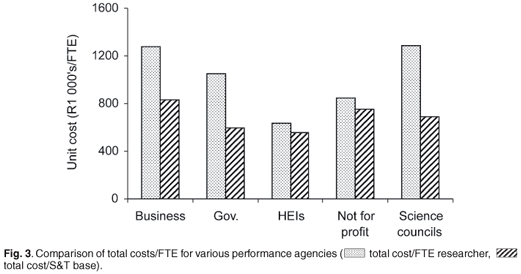
In the above analysis, caution should be taken to avoid an overly quantitative interpretation of the data, since different sectors and institutions follow different approaches to the allocation of costs. As a result, the overhead ratios may be underestimated due to the lack of complete activity-based costing within any single institution. The total cost per FTE S&T base remains a credible and important figure, however, because it forms the basis of the charge-out rate for contract research, and reflects the minimum annual income, which a single FTE in the S&T base needs to earn in order to cover the costs of his/her employment.
The above ranking of performance institutions can also be illustrated if one considers the costing of a 'standard' research project.a Consider a project which will last one year, it will employ one researcher and one technician, and running costs will amount to about 10% of the total project. The cost of such a project will vary from one sector to another as shown in Fig. 4.
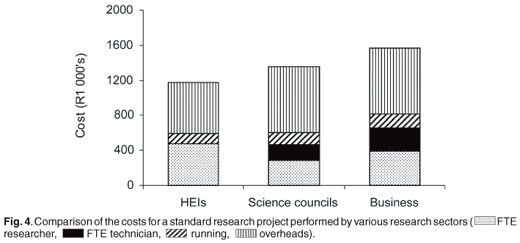
As already noted, such a project will be cheapest in the university sectorb (at 86% of the cost in the science councils) and most costly in the business sector (16% more expensive than the science councils), as may have been expected based on the previous discussion. It is noted that the science council costs are between those of the HEIs and government departments on the one hand, and the business sector on the other hand, reflecting a previous analysis which concluded that the impact of the mixed income model has been to drive up research costs in the PRIs5 relative to the HEIs.
It is important not to confuse cost with value. In the example above, the productivity between the three sectors may be very different, with the result that the same projects may take longer or shorter in each sector, depending on the quality of the research staff and the scientific infrastructure. So, although the HEIs may be the cheapest location for research, based on cost per hour, in South Africa, the cost per research output or deliverable and hence value to the client, may have a different ranking.
Unfortunately, the productivity of the different performance sectors is difficult to compare directly. However, an indirect comparison can be obtained by analysing the trends in business sector outsourcing to other performance institutions. Given the above cost analysis, it would be expected that business sector income to the HEIs should be rising relative to the science councils'. In fact, the opposite is true; income to the HEIs has been falling, whereas that to the science councils has been rising (see Fig. 5; data extracted from the annual R&D surveys). As a percentage of total business sector R&D funding, the science councils' has been relatively static over the period 2001 to 2005, whereas the university sector has received a declining proportion of the total funding.c This trend suggests but does not confirm that the value of research in the science councils is greater than that delivered by the HEIs, even though the unit costs are lower.
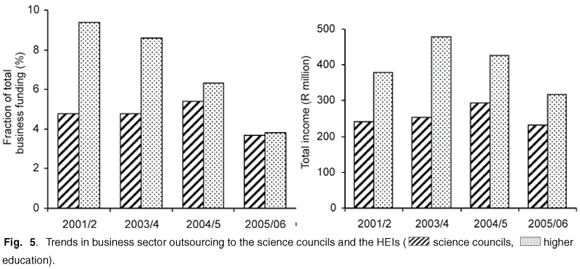
Comparison with recommended rates
The above data for FTE rates of researchers and technicians can be compared to the recommended rates for engineers2 and scientists3, as published annually in the Government Gazette, and that for auditors, as published in the relevant circular of the South African Institute of Chartered Accountants6 (see Table 1). The rates are defined according to the four categories of:
-
Category A: a top practitioner whose expertise and relevant experience is nationally or internationally recognized and who provides advice at a level of specialization where such advice is recognized as that of an expert.
-
Category B: a partner, a sole proprietor, a director, or a member who, jointly or severally with other partners, co-directors or co-members, bears the risks of the business, takes full responsibility for the liabilities of such practice, where level of expertise and relevant experience is commensurate with the position, performs work of a conceptual nature in natural science, engineering design and development, provides strategic guidance in planning and executing a project and/or carries responsibility for quality management pertaining to a project.
-
Category C: all salaried professional staff with adequate expertise and relevant experience performing work of a scientific or engineering nature and who carry the direct technical responsibility for one or more specific activities related to a project.
-
Category D: all other salaried technical staff with adequate expertise and relevant experience performing work of an engineering nature with direction and control provided by any person contemplated in categories A, B or C.

These recommended rates must now be converted to hourly rates before they can be compared with the research costs as obtained from the R&D survey. In the case of natural scientists, this is relatively straightforward as the rates are already hourly. For engineers and accountants the comparison is more difficult because TCOE rates are not available and certain assumptions must be made regarding billable hours. Assuming the billable hours per year are about 1600, based on total days minus the days for weekends, leave, holidays and training (leaving about 200 days at 8 hours per day) and an average TCOE for each category as shown in Table 2, the recommended rates can be converted to a common basis and compared between engineers and scientists as per Government Gazette and from the R&D survey (see Table 2).

It is clear that there is only a small difference between the recommended rates and the actual costs within the PRIs at the lower grades. The maximum grades are quite different, however, with the average FTE rates in the science councils being between categories B and C of the gazetted rates. Once again, the data are not strictly comparable since there are a number of critical assumptions, especially in respect of the number of billable hours and the average employee profile. However, the comparison does reveal two important points as follows:
-
the average hourly rates used by the HEIs and the PRIs to cost research projects are somewhat below the gazetted rates for scientists and engineers
-
the gazetted rates include a generous allowance for the overhead contribution, with the overhead ratio varying from 1.75 (times salary costs) in the case of the rates from the Auditor General, to 2.5 for engineering and scientific consultancies. As mentioned above, an overhead ratio of 1.7 is not unusual for any organization; it is critical that researchers from all performance institutions understand that this is a normal cost for overheads and to allow for these costs in their pricing of contract research, which they undertake at the request of external clients.
Comparison with international salary data
This article has not been written to provide comparative information on salaries within South Africa relative to other countries. However, a limited analysis has been undertaken to benchmark the results, as revealed by this study, on the relative ranking of labour costs (and hence salaries) within the three performance sectors (HEIs, PRIs and the business sector).
A similar trend to that noted in this article has been observed in other countries; for instance, salary surveys undertaken in the U.S. confirm that average salaries vary according to the performance sector (see Table 3). There is on average a 32% discount between an academic and a private sector or for-profit post for equivalent qualification and experience. The discount between PRIs and for-profit salaries is much smaller, varying between 0 and 10%, depending on the qualification.

Discussion and recommendations
It is clear from the information presented above, which is based on data extracted from the 2003/4 R&D survey, that there is a need to undertake various important tasks within the public research sector in order to harmonize the present practices and remove some perceptions around the apparent costs of research. These recommendations now follow:
-
Overhead costs for research projects vary between 1.2 and 1.7 times the direct labour costs (researchers and technicians) for all institutions, regardless of the performance sector. To claim that overheads are lower than this rate is to perpetuate a misconception about the extent of overhead costs and to force the subsidization of these costs through other activities of the performance institution.
-
It is important that all institutions, including the universities, implement full-cost accounting and a common pricing model. This will help considerably in creating a common understanding about the real cost of research and will stop the cross-subsidization of contract research through other revenue streams within the institution. The Innovation Fund is presently looking in more detail at a pricing policy that would harmonize its support across all sectors and establish the 'fair value of money' (in other words, establishing how much research can be purchased per unit of funding).
-
The public research institutions must seek to increase the number of less experienced and hence lower paid researchers and to re-establish a culture of public interest research, leading to a gradual decrease in the overall cost of salaries per FTE researcher. The latter institutions can be found in all developed, and many developing, countries and generally occupy a unique and mostly privileged position within a national system of innovation (between the HEIs and the business sector). Researchers in PRIs have a certain level of intellectual freedom (in other words, the opportunity to pursue their own research ideas and agendas within the framework of a set of national priorities) without the burden of either teaching or having to deliver direct economic returns to a set of shareholders. As a result, it is reasonable to expect that salaries in this sector should be discounted relative to those of a similar peer group in the business or private sectord (at about 10% as stated above), but higher relative to the tertiary educational institutions. In essence, the labour market appears to reflect an equivalent value to intellectual freedom and public service; the higher the degree of freedom and opportunity to act in the public interest (as opposed to shareholder gain), the higher the discount.
-
The HEIs and the PRIs need to undertake an annual salary survey for researchers. At present, the salaries of researchers are benchmarked against business or private sector companies. The development of a public sector salary survey will be highly beneficial for the research community in two respects; it will serve to temper the expectations of the researchers employed in this sector, and assist government and other regulatory agencies in understanding the behaviour of the S&T labour market.
Conclusion
The data from the R&D survey have been used to derive the cost of research for the various performance sectors in South Africa. The analysis indicates that this cost is highest in the business sector, which is not surprising given that the R&D efforts within this sector are generally better resourced with both people and equipment. The HEIs are the lowest cost performers.
Although the cost of research in the science councils is higher than that in the HEIs, the difference is not large (about 16% for a 'standard' project), which seems to contradict the perception that salaries and overhead costs in the science councils are way ahead of those in the universities. Similarly, it is shown that the research costs in general are somewhat less than the recommended rates for auditors, engineers and scientists as published in a number of government gazettes and updated annually in terms of the relevant legislation.
These results suggest that there is a need for two annual activities if the country is to derive maximum benefit from an increased R&D expenditure; namely, the undertaking of an annual salary survey which is focused on public sector researchers, and the implementation of full-cost accounting in all institutions performing public research. The latter in particular will help to change the present perceptions, and indeed misconceptions, about the relative costs of research between universities and science councils.
The assistance of Michael Kahn and Neo Molotja of the Centre for Science, Technology and Innovation Indicators at the Human Sciences Research Council, with the provision of data covering the labour costs of various sub-sectors within the HEIs, is gratefully acknowledged.
1. Department of Science and Technology (2006). National Survey of Research and Experimental Development (R&D); High Level Key Results 2004/5 Fiscal Year. Pretoria. Also online at: www.hsrc. ac.za [ Links ]
2. Data on rates for engineers obtained from the Government Gazette, No. 29729, 30 March 2007, pp. 98–148. [ Links ]
3. Data on rates for scientists obtained from the Government Gazette, No. 29716, 23 March 2007, p. 38. [ Links ]
4. Human Sciences Research Council (2006). National Survey of Research and Experimental Development (R&D); Fiscal Year 2004/5. Cape Town. Additional information was also obtained directly from the HSRC. [ Links ]
5. Walwyn D. (2006). The impact of a mixed income model on the South African CSIR; a recipe for success or disaster? S. Afr. J. Sci. 102, 239–243. [ Links ]
6. The South African Institute of Chartered Accountants (2006). Interim guideline for fees done on behalf of the Auditor General. Circular 6/2006. Johannesburg. [ Links ]
Received 8 June 2007. Accepted 17 April 2008.
a It is noted that the comparison presented in this paragraph is based on cost and not price, which is technically incorrect. However, most public research institutions in South Africa operate on a zero or minimal margin. In other words, cost is equivalent to price.
b Note that since the university sector employs few technicians, it is assumed that the project in this sector will be undertaken by two researchers (there is very little impact on the overall cost as a result of this assumption).
c It is unfortunate that more recent information was not available at the time of preparing this article.
d Data on salaries of engineers and scientists by sector (government, PRI and private) can be obtained from various surveys including the annual Institute of Electronic and Electrical Engineers salary survey and the National Science Foundation's Science and Engineering Indicators Report.














